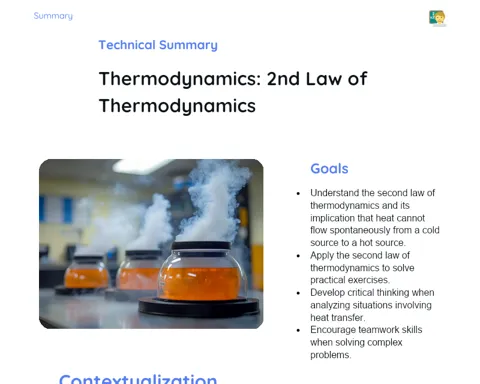Exploring the World of Lenses: Converging and Diverging
Objectives
1. Identify and differentiate the two main types of lenses: converging and diverging.
2. Describe the properties and characteristics of converging and diverging lenses.
3. Recognize the practical applications of these lenses in various work market contexts.
Contextualization
The physics of lenses is an essential part of the study of optics, with practical applications in various areas of everyday life and science. From vision correction with glasses and contact lenses to the use in technological devices such as cameras, microscopes, and telescopes, lenses play a fundamental role in our ability to observe and interact with the world around us. Understanding the different types of lenses and their properties is crucial for the development of technologies that improve quality of life and drive scientific advancements.
Relevance of the Theme
The study of lenses is of great importance in the current context, as it is directly linked to various technological and scientific fields. Professionals such as optometrists, optical engineers, and optical device designers use knowledge about lenses to develop and improve products that meet health and technology needs. Furthermore, understanding lenses is fundamental for the development of new tools that facilitate observation and scientific analysis, contributing to the advancement of human knowledge.
Converging Lenses (Convex)
Converging lenses, or convex lenses, are those that cause parallel rays of light passing through them to meet at a point, called the focus. These lenses are thicker in the middle than at the edges and are primarily used to magnify images of nearby objects, such as in magnifying glasses and microscopes.
-
Focus: The point where rays of light converge after passing through the lens.
-
Thickness: Thicker in the center than at the edges.
-
Applications: Correction of hyperopia, magnifying glasses, microscopes.
Diverging Lenses (Concave)
Diverging lenses, or concave lenses, spread the rays of light passing through them, making them appear to diverge from a common point. These lenses are thinner in the center than at the edges and are often used to correct myopia, as well as being used in equipment like binoculars.
-
Divergence: Rays of light appear to diverge from a common point after passing through the lens.
-
Thickness: Thinner in the center than at the edges.
-
Applications: Correction of myopia, binoculars, telescopes.
Properties and Characteristics of Lenses
The properties of lenses include characteristics such as the focal length, which is the distance between the center of the lens and the point where the rays of light meet (in the case of converging lenses) or appear to diverge (in the case of diverging lenses). It is also important to consider the shape of the lens, which affects how it refracts light.
-
Focal Length: The distance between the center of the lens and the focus.
-
Refraction: The change in direction of light rays as they pass through the lens.
-
Shape: The shape of the lens, whether convex or concave, determines its optical properties.
Practical Applications
- Glasses and Contact Lenses: Use converging lenses to correct hyperopia and diverging lenses to correct myopia, providing clear vision for users.
- Cameras: Use converging lenses to focus light and create sharp images on sensors or photographic film.
- Microscopes and Telescopes: Use combinations of converging and diverging lenses to magnify and observe very small or distant objects, respectively.
Key Terms
-
Converging Lens: A lens that causes parallel rays of light to converge at a focus.
-
Diverging Lens: A lens that causes parallel rays of light to appear to diverge from a common point.
-
Focal Length: The distance between the center of the lens and the point where the rays of light meet or appear to diverge.
Questions
-
How can knowledge about lenses influence the development of new technologies in the future?
-
In what way do the lenses we use in everyday life, such as in glasses and cameras, improve our quality of life?
-
What challenges do scientists face when designing lenses for specific applications, such as space telescopes or electron microscopes?
Conclusion
To Reflect
Throughout this study, we explored the different types of lenses and their fundamental properties. We understood how converging and diverging lenses manipulate light rays to create images and saw their practical applications in various contexts. The importance of these lenses is evident in many areas of our daily life, such as in vision correction and imaging technology. Reflecting on these aspects allows us to perceive how the physics of lenses not only improves our quality of life but also drives technological and scientific advancements. By mastering these concepts, we are better prepared to face challenges in the job market and contribute to technological innovation.
Mini Challenge - Practical Challenge: Designing a Simple Magnifying Glass
Create a magnifying glass using a converging lens and explore its optical properties.
- Gather the materials: a converging lens, a flashlight, a ruler, and graph paper.
- Position the converging lens on a stand and point the flashlight through the lens.
- Adjust the distance between the lens and the graph paper until the projected image is in focus.
- Measure the focal length (the distance between the lens and the point where the image is sharpest) using the ruler.
- Draw a diagram that shows the path of light rays through the lens to the focal point.
- Note your observations on how the image changes as you alter the distance between the lens and the paper.
- Compare your findings with the theoretical concepts discussed in class.



